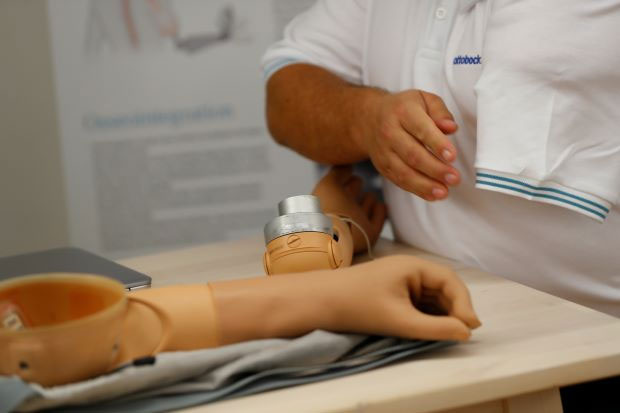Biological arms controlled by brain signals
Austrian scientists have introduced a prosthetic arm that can be controlled by thought, bringing new perspectives to people with disabilities.
For ordinary people, brushing and shaving is a simple matter. But for Edmund Rath, who lost his left arm in a truck accident last year, this is like an irony.
Fortunately, in May he was selected by Austrian surgeons who were the first to participate in prosthetic surgery that could use brain signals to control.

Edmund Rath can control biological arms with signals from the brain.At the same time, this arm can also send signals in the opposite direction.
This process was known as bone integration (osseointegration, or OI for short) , including implanting a metal rod into the bone on Rath's other arm. This metal bar has an external joint with the forearm then the doctor attaches it to his biceps.
During the live televised surgery, the doctors took the nerves used to control Rath's arm and connected them to the muscle on the other arm. Doctors call this procedure the restoration of nerve function of specific muscle areas.
And so, when he thought about moving his hands, the muscles on his shoulder blades shrunk and were perceived by the electrodes in the prosthetic arm to help him make intentional movements. Moreover, this arm can also send signals in the opposite direction.
Edmund Rath happily shared: ' Ordinary prosthetics will not bring any freedom. You can hardly move them back, forward or left or right. But with this arm I can move like a real hand. Now I was able to lift my arm over my head to wear my shirt. I can even bend my elbows into this. '

The biological arm made by Austrian scientists can help users to perform six functions, including grasping and opening hands.
After nearly 6 months of installing a brain-controlled biological hand, Rath was able to perform 6 different functions of this special arm, including grasping and opening the hand.
"I have no intention of changing the world, but every day, practicing to control my hands is my goal. I wish I could take care of myself as quickly as possible." , brother Edmund Rath said.
Worldwide there are millions of people living in the situation of losing their hands or feet, in which the US alone has 2 million people. This number is expected to increase even higher due to common diseases such as diabetes.
Austrian scientists said the next step would be to complete and test the tactile feedback system on the arm so that patients could easily feel the difference between surfaces. , or a holding object.
The OI technique was first invented by Swedish researcher Per-Ingvar Branemark in the 1950s and is primarily used in dental bone graft surgery. One feature of OI technology is that users can sense some sensations from mechanical vibrations in their jaw bone but do not have the corresponding technique to recover touch.
- Manufacturing robot arms is controlled by the brain
- Scientists have successfully developed brain-controlled robotic hands
- The unexpected thing about the human body
- Artificial hands controlled by thought
- Science can read human thoughts with black and white paper
- Control quadcopter aircraft by thinking
- Can the human brain be hacked?
- Drive the plane with thoughts
- Samsung will soon test brain-controlled TVs
- Technology turns brain signals into words, helping polio patients communicate
- The human brain is depressed
- Detecting the biological clock 'adjustment button' of the human body
 Green tea cleans teeth better than mouthwash?
Green tea cleans teeth better than mouthwash? Death kiss: This is why you should not let anyone kiss your baby's lips
Death kiss: This is why you should not let anyone kiss your baby's lips What is salmonellosis?
What is salmonellosis? Caution should be exercised when using aloe vera through eating and drinking
Caution should be exercised when using aloe vera through eating and drinking